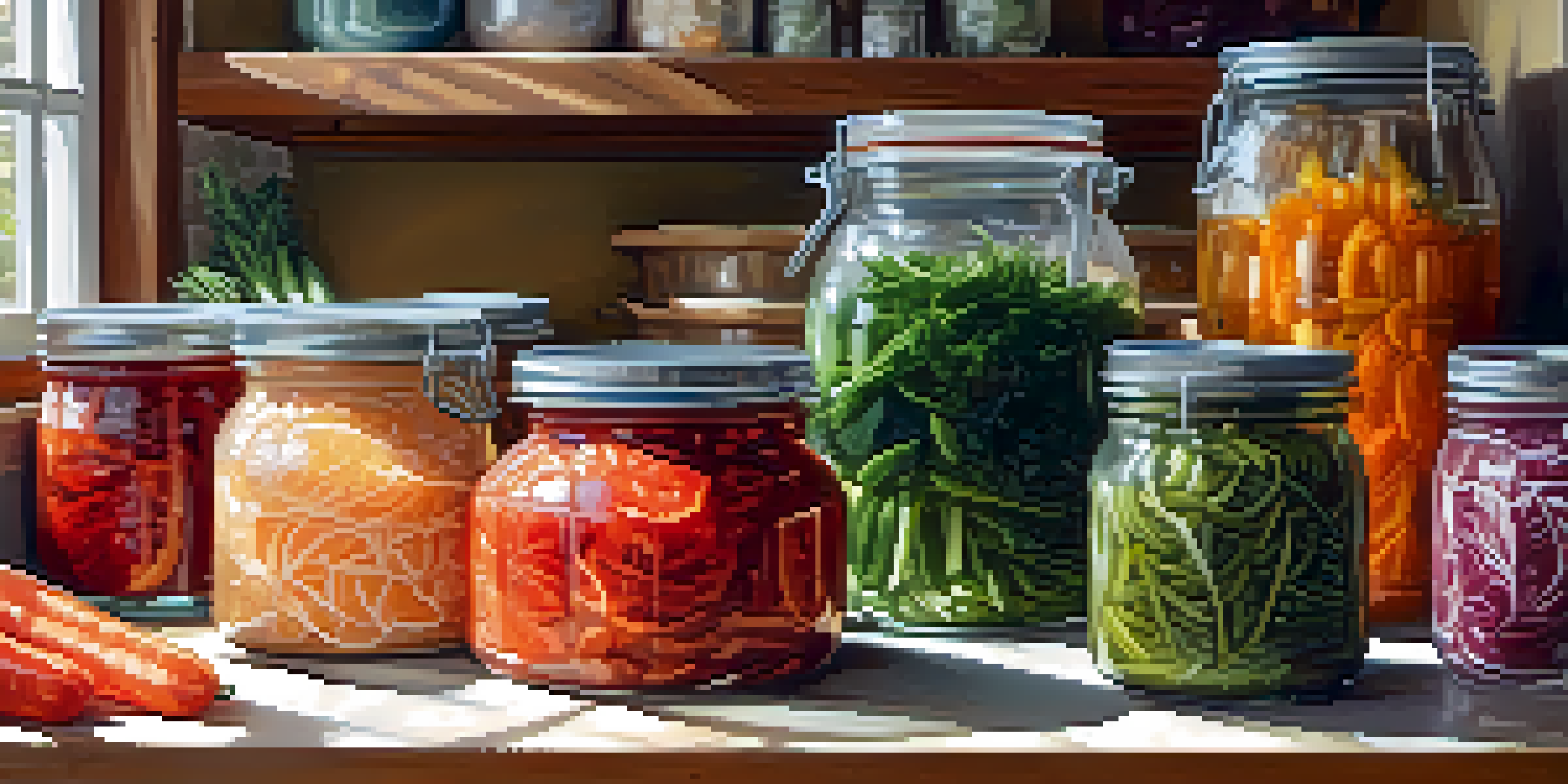The Science Behind Plant-Based Fermentation Explained

Understanding Plant-Based Fermentation: The Basics
Plant-based fermentation is a natural process where microorganisms like bacteria, yeast, and mold convert sugars and starches into acids, gases, or alcohol. This transformation not only enhances the flavor of food but also increases its nutritional value. Think of it like a culinary magic trick that turns simple ingredients into something extraordinary.
Fermentation is the ultimate form of creativity in cooking, transforming simple ingredients into extraordinary flavors.
At its core, fermentation is an ancient preservation method, dating back thousands of years. It’s how we get delicious foods like yogurt, sauerkraut, and kimchi. When you see these products on the shelf, remember that they are the result of complex interactions between microorganisms and the food itself.
This process not only prolongs shelf life but also boosts probiotics—beneficial bacteria that aid digestion. So, when you dig into a bowl of fermented veggies, you’re not just enjoying the taste; you’re also giving your gut a healthful treat.
The Role of Microorganisms in Fermentation
Microorganisms are the unsung heroes of fermentation. They play pivotal roles in breaking down carbohydrates and producing beneficial compounds. For example, lactic acid bacteria are primarily responsible for fermenting dairy and plant-based products, converting sugars into lactic acid, which gives yogurt its tangy flavor.

Different microorganisms can create various flavors and textures in fermented foods. Yeasts, for instance, are essential for brewing beer and making bread rise. Each type of microbe brings its own personality to the fermentation party, resulting in a wide array of delicious outcomes.
Fermentation Boosts Food Flavor
Plant-based fermentation transforms simple ingredients into flavorful and nutritious foods through the action of microorganisms.
Understanding these microorganisms helps us appreciate the art and science of fermentation. It’s like knowing the secret ingredients of a recipe that make everything come together perfectly.
The Benefits of Fermented Plant-Based Foods
Fermented plant-based foods are packed with health benefits. They are rich in probiotics, vitamins, and minerals that can enhance gut health and boost the immune system. Regular consumption can even improve digestion, making it easier for your body to absorb nutrients from other foods.
The science of fermentation is the art of allowing nature to take its course, creating a symphony of flavors and health benefits.
Moreover, fermentation can increase the bioavailability of certain nutrients, meaning your body can access them more easily. For example, the fermentation of soybeans to create miso enhances its protein content and makes the minerals more absorbable.
So, adding fermented foods to your diet isn’t just about flavor; it’s a smart way to nourish your body. It’s like giving yourself a little health boost with every bite.
How to Make Your Own Fermented Foods at Home
Making your own fermented foods at home is easier than you might think! All you need are some basic ingredients, a clean jar, and a willingness to experiment. For instance, you can start with something simple like sauerkraut, which requires just cabbage and salt.
The process involves mixing chopped cabbage with salt and letting it sit in a jar. As it ferments over several days, the natural sugars in the cabbage are converted into lactic acid, resulting in that signature tangy flavor. It’s a fun and rewarding project that can fill your kitchen with delightful aromas.
Health Benefits of Fermented Foods
Regular consumption of fermented plant-based foods enhances gut health and increases nutrient absorption.
Plus, by making your own fermented foods, you can customize flavors and ensure everything is fresh. It’s like turning your kitchen into a mini-laboratory, where you’re both the scientist and the chef!
Common Types of Plant-Based Fermented Foods
There are numerous types of plant-based fermented foods to explore! Some of the most popular include kimchi, kefir, tempeh, and kombucha. Each offers unique flavors and health benefits, making them great additions to any meal.
For example, kimchi is a spicy fermented vegetable dish that’s rich in vitamins A and C, while tempeh is a fermented soy product high in protein. Kombucha, a fizzy tea, provides a refreshing probiotic drink that many people enjoy.
With such a variety available, it’s easy to find fermented foods that suit your taste. Think of it as a flavorful adventure for your palate!
Safety Tips for Fermentation at Home
While fermenting at home can be fun, it’s important to prioritize safety. Always use clean utensils and jars to prevent unwanted bacteria from spoiling your food. A simple rinse with hot soapy water can go a long way in ensuring a successful fermentation process.
Additionally, it’s crucial to monitor your fermentation closely. If you notice any off-smells, colors, or molds, it’s best to err on the side of caution and discard the batch. Trust your senses—if something seems off, it probably is.
DIY Fermentation is Easy and Fun
Making fermented foods at home allows for customization and is a rewarding culinary experiment.
By following these safety tips, you can enjoy the health benefits of homemade fermented foods without worry. It’s all about creating a safe and enjoyable kitchen experience.
The Future of Plant-Based Fermentation
The future of plant-based fermentation looks bright and promising! As more people turn to plant-based diets, the demand for innovative fermented products is on the rise. This trend has led to exciting advancements in fermentation techniques and flavors.
Moreover, researchers are exploring the potential of fermentation in addressing food waste by using unwanted produce to create new fermented products. This not only reduces waste but also promotes sustainability in our food systems.

With creativity and science combining, we can expect to see a wider variety of delicious and nutritious fermented foods emerging in the market. It’s an exciting time to be a fan of fermentation!